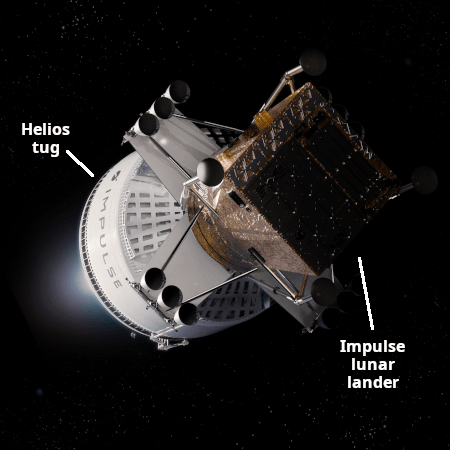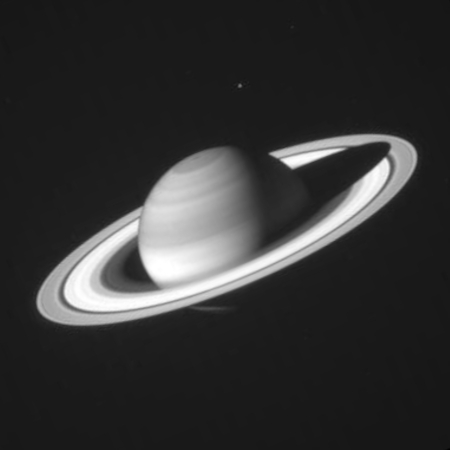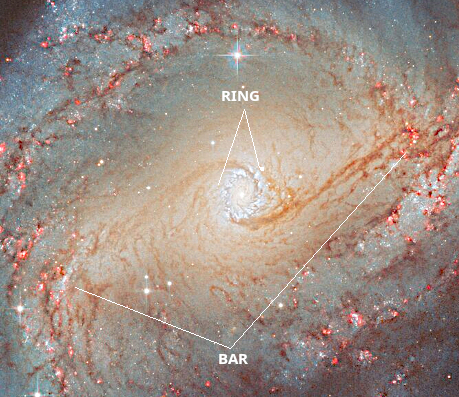Tag: engineering
Peeling brain terrain in Martian crater
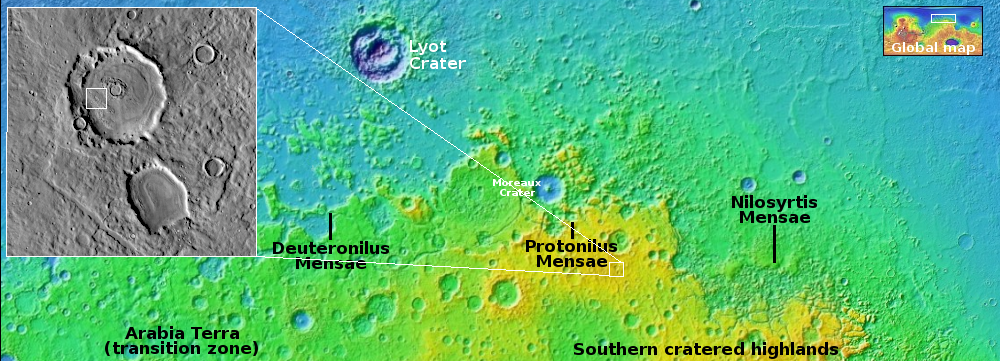
Today’s cool image takes us once again back to Mars’ glacier country, the 2,000 mile-long mid-latitude strip in the northern hemisphere where almost every image shows glacier features. The picture to the right, cropped, reduced, and sharpened to post here, was taken on September 4, 2025 by the high resolution camera on Mars Reconnaissance Orbiter. It shows a small section of the floor of an unnamed 13-mile-wide crater, highlighting what the science team labels vaguely as “features.”
Those features appear to be glacial debris whose surface alternates between peeling gaps and the unique Martian geology dubbed “brain terrain”, whose formation is not yet understood but is believed to be associated with near surface ice.
The location is indicated by the white rectangle on the overview map above. At 36 degrees north latitude, this crater is deep within that mid-latitude strip where a lot of glacial features are routinely found. If you look at the inset, you can see that all the nearby craters appear to have formed in what appears to be slushy ground, their rims not very pronounced or distorted and their floors shallow, as if the ground melted like ice upon impact but very quickly solidified.
Mars is not a dry place. Future colonists will likely build their first cities around 30 degrees latitude, close enough to the equator to get warmer temperatures, but close enough to the near-surface ice found just a few degrees poleward, in a place such as this.

Today’s cool image takes us once again back to Mars’ glacier country, the 2,000 mile-long mid-latitude strip in the northern hemisphere where almost every image shows glacier features. The picture to the right, cropped, reduced, and sharpened to post here, was taken on September 4, 2025 by the high resolution camera on Mars Reconnaissance Orbiter. It shows a small section of the floor of an unnamed 13-mile-wide crater, highlighting what the science team labels vaguely as “features.”
Those features appear to be glacial debris whose surface alternates between peeling gaps and the unique Martian geology dubbed “brain terrain”, whose formation is not yet understood but is believed to be associated with near surface ice.
The location is indicated by the white rectangle on the overview map above. At 36 degrees north latitude, this crater is deep within that mid-latitude strip where a lot of glacial features are routinely found. If you look at the inset, you can see that all the nearby craters appear to have formed in what appears to be slushy ground, their rims not very pronounced or distorted and their floors shallow, as if the ground melted like ice upon impact but very quickly solidified.
Mars is not a dry place. Future colonists will likely build their first cities around 30 degrees latitude, close enough to the equator to get warmer temperatures, but close enough to the near-surface ice found just a few degrees poleward, in a place such as this.
New Morgan Stanley report reflects Wall Street’s generally optimistic view of Rocket Lab
Though Rocket Lab is still not in the black, a new positive analysis of the company this week from Morgan Stanley reflects Wall Street’s generally optimistic view of Rocket Lab during the past year.
Rocket Lab (NASDAQ:RKLB) had its price target raised by equities researchers at Morgan Stanley from $20.00 to $68.00 in a research report issued on Monday, Benzinga reports. The brokerage presently has an “equal weight” rating on the rocket manufacturer’s stock. Morgan Stanley’s price target would suggest a potential upside of 1.63% from the company’s current price.
The article at the link also notes that Morgan Stanley is not alone in giving Rocket Lab a positive report, and in fact in the past year it shows that the recommendations from many analysts to buy its stock have risen considerably. These positive reviews have been reflected in a steady rise in the company’s stock price in 2025, as shown by the graph on the right.
Nor are these reports written in a vacuum. In recent weeks Rocket Lab has signed a bunch of new launch contracts, some extending deals with old customers, some with new customers of some note.
Buying the stock of a startup like Rocket Lab always carries risk, but it appears Wall Street is beginning to see the future of this particular startup as very promising.
Though Rocket Lab is still not in the black, a new positive analysis of the company this week from Morgan Stanley reflects Wall Street’s generally optimistic view of Rocket Lab during the past year.
Rocket Lab (NASDAQ:RKLB) had its price target raised by equities researchers at Morgan Stanley from $20.00 to $68.00 in a research report issued on Monday, Benzinga reports. The brokerage presently has an “equal weight” rating on the rocket manufacturer’s stock. Morgan Stanley’s price target would suggest a potential upside of 1.63% from the company’s current price.
The article at the link also notes that Morgan Stanley is not alone in giving Rocket Lab a positive report, and in fact in the past year it shows that the recommendations from many analysts to buy its stock have risen considerably. These positive reviews have been reflected in a steady rise in the company’s stock price in 2025, as shown by the graph on the right.
Nor are these reports written in a vacuum. In recent weeks Rocket Lab has signed a bunch of new launch contracts, some extending deals with old customers, some with new customers of some note.
Buying the stock of a startup like Rocket Lab always carries risk, but it appears Wall Street is beginning to see the future of this particular startup as very promising.
Orbital tug startup Impulse Space to develop its own unmanned lunar lander
The orbital tug startup Impulse Space, founded by Tom Mueller (one of SpaceX’s first engineers), is now proposing to build its own unmanned lunar lander, with a target for delivering six tons of cargo on two missions, starting in 2028.
Our proposed architecture combines our existing Helios kick stage and a new lunar lander, to be developed by our team in-house. Helios would launch on a standard medium- or heavy-lift rocket. Our lunar lander would ride as a payload on Helios. Once Helios and the lander are deployed in Low Earth Orbit (LEO), Helios serves as a cruise stage, transporting the lander to low lunar orbit within one week. The lunar lander then separates from Helios and descends to the surface of the Moon. By taking advantage of Helios’s high delta-v capabilities, this mission architecture doesn’t require in-space refueling.
This solution can bridge the existing cargo delivery gap by offering direct transportation of the necessary mass to kickstart infrastructure, resource utilization, and economic activities on the Moon. We’ve already begun engine development for our lunar lander solution, and we stand ready to execute as dictated by industry demand and interest.
With this Helios and Impulse-made lander combination, we estimate delivering up to 6 tons of payload mass to the Moon (across two missions) per year starting in 2028 at a cost-effective price point. Each Helios + lander combo would take approximately 3 tons of cargo to the Moon.
It appears the company has identified a need (transporting cargo to the Moon cheaply and quickly) that no one (including NASA) is presently considering. SpaceX will be able to do it with Starship. Blue Origin is also proposing to do it with various versions of its Blue Moon manned lander. Impulse has decided however that both of those spacecraft are too large and tied to SLS and Lunar Gateway, with Starship requiring refueling, that makes their cargo missions more costly than a direct mission. Impulse proposes a simpler option.
This decision is also another indication that the demand for low orbital tugs is not developing as expected. It appears satellite companies and the available rocket companies have worked out ways to get most of their satellites to the orbits they require without tugs.
It will be interesting to watch if this proposal gains traction. If it does, than it will likely encourage other orbital tug as well as the other lunar lander companies to propose their own alternatives.
The orbital tug startup Impulse Space, founded by Tom Mueller (one of SpaceX’s first engineers), is now proposing to build its own unmanned lunar lander, with a target for delivering six tons of cargo on two missions, starting in 2028.
Our proposed architecture combines our existing Helios kick stage and a new lunar lander, to be developed by our team in-house. Helios would launch on a standard medium- or heavy-lift rocket. Our lunar lander would ride as a payload on Helios. Once Helios and the lander are deployed in Low Earth Orbit (LEO), Helios serves as a cruise stage, transporting the lander to low lunar orbit within one week. The lunar lander then separates from Helios and descends to the surface of the Moon. By taking advantage of Helios’s high delta-v capabilities, this mission architecture doesn’t require in-space refueling.
This solution can bridge the existing cargo delivery gap by offering direct transportation of the necessary mass to kickstart infrastructure, resource utilization, and economic activities on the Moon. We’ve already begun engine development for our lunar lander solution, and we stand ready to execute as dictated by industry demand and interest.
With this Helios and Impulse-made lander combination, we estimate delivering up to 6 tons of payload mass to the Moon (across two missions) per year starting in 2028 at a cost-effective price point. Each Helios + lander combo would take approximately 3 tons of cargo to the Moon.
It appears the company has identified a need (transporting cargo to the Moon cheaply and quickly) that no one (including NASA) is presently considering. SpaceX will be able to do it with Starship. Blue Origin is also proposing to do it with various versions of its Blue Moon manned lander. Impulse has decided however that both of those spacecraft are too large and tied to SLS and Lunar Gateway, with Starship requiring refueling, that makes their cargo missions more costly than a direct mission. Impulse proposes a simpler option.
This decision is also another indication that the demand for low orbital tugs is not developing as expected. It appears satellite companies and the available rocket companies have worked out ways to get most of their satellites to the orbits they require without tugs.
It will be interesting to watch if this proposal gains traction. If it does, than it will likely encourage other orbital tug as well as the other lunar lander companies to propose their own alternatives.
The hurricane season in 2024 confounded the predictions again

The uncertainty of science: Though the climate science community had predicted that last year’s hurricane season was going to be one of the most active ever, a new study published two weeks ago in Geophysical Research Letters of the American Geophysical Union (AGU) found that the 2024 season did not behave as predicted. It ended up producing about the predicted number of hurricanes, but did so only because of a sudden rise in activity near the end of the season, after a long lull with almost no activity. From the study’s conclusion:
As has been noted throughout this study, the lull was immediately followed by one of the busiest ends to an Atlantic hurricane season on record, including two major hurricane landfalls in Florida (Helene and Milton), resulting in more than 250 fatalities and $100 billion in damage (National Centers for Environmental Information, 2025). Though the final overall number of hurricanes and major hurricanes were aligned with the seasonal forecasts, the extremely busy beginning and end to the season and marked lull in the middle highlight just how unusual the season was.
Last year’s prediction was not the first to be incorrect, though this time the error was in how the season unfolded instead of the total numbers. In the past two decades — since Al Gore prophesied that global warming would cause a gigantic increase in violent storms — NOAA has repeatedly called for very active hurricane seasons, and repeatedly those predictions have turned out wrong. In fact, from 2006 until 2018 there were almost no major hurricanes at all, the exact opposite to what Gore had foretold. Since then the seasons have returned to more normal numbers, but the predictions of the scientists have continued to be no better than throwing a dart at a wall while wearing a blindfold.
The ongoing 2025 hurricane season is following this same pattern. In May 2025 NOAA predicted this year would be a very active hurricane season. Instead, this season has matched those from 2006 to 2016, in which no hurricanes made landfall in the U.S. and the number of strong hurricanes was almost nil.
The season of course is not yet over. We could see a burst of activity in the next few months, similar to what happened in 2024. Nonetheless, the important takeaway from this story is that the scientists who claim to know what is going to happen simply don’t know anything. They are guessing, because as the paper above admits, the Earth’s weather and climate are incredibly complex, and our understanding of it is still in its infancy.
Remember this when you read the next “We’re all gonna die!” prediction touted in the propaganda press.

The uncertainty of science: Though the climate science community had predicted that last year’s hurricane season was going to be one of the most active ever, a new study published two weeks ago in Geophysical Research Letters of the American Geophysical Union (AGU) found that the 2024 season did not behave as predicted. It ended up producing about the predicted number of hurricanes, but did so only because of a sudden rise in activity near the end of the season, after a long lull with almost no activity. From the study’s conclusion:
As has been noted throughout this study, the lull was immediately followed by one of the busiest ends to an Atlantic hurricane season on record, including two major hurricane landfalls in Florida (Helene and Milton), resulting in more than 250 fatalities and $100 billion in damage (National Centers for Environmental Information, 2025). Though the final overall number of hurricanes and major hurricanes were aligned with the seasonal forecasts, the extremely busy beginning and end to the season and marked lull in the middle highlight just how unusual the season was.
Last year’s prediction was not the first to be incorrect, though this time the error was in how the season unfolded instead of the total numbers. In the past two decades — since Al Gore prophesied that global warming would cause a gigantic increase in violent storms — NOAA has repeatedly called for very active hurricane seasons, and repeatedly those predictions have turned out wrong. In fact, from 2006 until 2018 there were almost no major hurricanes at all, the exact opposite to what Gore had foretold. Since then the seasons have returned to more normal numbers, but the predictions of the scientists have continued to be no better than throwing a dart at a wall while wearing a blindfold.
The ongoing 2025 hurricane season is following this same pattern. In May 2025 NOAA predicted this year would be a very active hurricane season. Instead, this season has matched those from 2006 to 2016, in which no hurricanes made landfall in the U.S. and the number of strong hurricanes was almost nil.
The season of course is not yet over. We could see a burst of activity in the next few months, similar to what happened in 2024. Nonetheless, the important takeaway from this story is that the scientists who claim to know what is going to happen simply don’t know anything. They are guessing, because as the paper above admits, the Earth’s weather and climate are incredibly complex, and our understanding of it is still in its infancy.
Remember this when you read the next “We’re all gonna die!” prediction touted in the propaganda press.
Three launches in the past day
Even as all eyes focused on SpaceX’s 11th test launch of Starship/Superheavy yesterday, there were three other launches in the past fourteen hours taking place on three different continents by China and two different American companies.
First, China placed a technology test satellite into orbit, its Long March 2D rocket lifting off from its Jiuquan spaceport in northwest China. The only information about the satellite is that it will test “new optical imaging.” No information at all was released on where the rocket’s lower stages, using very toxic hypergolic fuels, crashed inside China.
Next, SpaceX placed 24 of Amazon’s Kuiper satellites into orbit, its Falcon 9 rocket lifting off from Cape Canaveral in Florida. The first stage completed its second flight, landing on a drone ship in the Atlantic.
With this launch, Amazon now has 154 satellites in orbit, out of a planned constellation of about 3,200. Its FCC license requires it to have about 1,600 in orbit by July of ’26, but that goal seems increasingly unlikely to be met. With this launch SpaceX completed its three-launch contract for Amazon. It has contracts with ULA for 46 launches (having so far completed three in 2025), and that company appears ready to launch regularly in the coming months. Amazon’s other launch contracts with Blue Origin’s New Glenn (27 launches) and ArianeGroup’s Ariane-6 (18 launches) however are more uncertain. Neither company has achieved any launches on their contracts, and it is not clear when either company, especially Blue Origin, will ever begin regular launches.
Finally, this morning Rocket Lab placed the seventh radar satellite into orbit for the company Synspective, its Electron rocket lifting off from one of its two launchpads in New Zealand. Rocket Lab has a contract for another twenty Synspective launches over the next few years. The launch also featured a larger fairing that will give the company the ability to launch bigger-sized satellites with Electron.
The leaders in the 2025 launch race, now including yesterday’s Starship/Superheavy launch:
131 SpaceX
60 China
13 Russia
13 Rocket Lab
SpaceX now leads the rest of the world in successful launches, 131 to 101.
Even as all eyes focused on SpaceX’s 11th test launch of Starship/Superheavy yesterday, there were three other launches in the past fourteen hours taking place on three different continents by China and two different American companies.
First, China placed a technology test satellite into orbit, its Long March 2D rocket lifting off from its Jiuquan spaceport in northwest China. The only information about the satellite is that it will test “new optical imaging.” No information at all was released on where the rocket’s lower stages, using very toxic hypergolic fuels, crashed inside China.
Next, SpaceX placed 24 of Amazon’s Kuiper satellites into orbit, its Falcon 9 rocket lifting off from Cape Canaveral in Florida. The first stage completed its second flight, landing on a drone ship in the Atlantic.
With this launch, Amazon now has 154 satellites in orbit, out of a planned constellation of about 3,200. Its FCC license requires it to have about 1,600 in orbit by July of ’26, but that goal seems increasingly unlikely to be met. With this launch SpaceX completed its three-launch contract for Amazon. It has contracts with ULA for 46 launches (having so far completed three in 2025), and that company appears ready to launch regularly in the coming months. Amazon’s other launch contracts with Blue Origin’s New Glenn (27 launches) and ArianeGroup’s Ariane-6 (18 launches) however are more uncertain. Neither company has achieved any launches on their contracts, and it is not clear when either company, especially Blue Origin, will ever begin regular launches.
Finally, this morning Rocket Lab placed the seventh radar satellite into orbit for the company Synspective, its Electron rocket lifting off from one of its two launchpads in New Zealand. Rocket Lab has a contract for another twenty Synspective launches over the next few years. The launch also featured a larger fairing that will give the company the ability to launch bigger-sized satellites with Electron.
The leaders in the 2025 launch race, now including yesterday’s Starship/Superheavy launch:
131 SpaceX
60 China
13 Russia
13 Rocket Lab
SpaceX now leads the rest of the world in successful launches, 131 to 101.
PLD issues detailed update on its preparations for first launch in 2026
The Spanish rocket startup PLD today released a detailed video update outlining the work it is doing designing and building its Miura-5 rocket for its first launch, now targeting 2026.
I have embedded that video below. Its engineers and managers describe and show in detail the hard metal they are cutting. Their goal is to produce one upper stage engine every two weeks by the end of this year. The company has already build eight tanks for both stages, and has even tested one tank to failure. PLD has also started construction of its launch site in French Guiana.
All in all, PLD seems moving aggressively towards that first launch, making it one of three European rocket startups on the brink of operations. The other two are Isar Aerospace and Rocket Factory Augsburg, both from Germany.
The Spanish rocket startup PLD today released a detailed video update outlining the work it is doing designing and building its Miura-5 rocket for its first launch, now targeting 2026.
I have embedded that video below. Its engineers and managers describe and show in detail the hard metal they are cutting. Their goal is to produce one upper stage engine every two weeks by the end of this year. The company has already build eight tanks for both stages, and has even tested one tank to failure. PLD has also started construction of its launch site in French Guiana.
All in all, PLD seems moving aggressively towards that first launch, making it one of three European rocket startups on the brink of operations. The other two are Isar Aerospace and Rocket Factory Augsburg, both from Germany.
Swarm satellite constellation detects changes in the Earth’s magnetic field during the past decade
The European Space Agency’s three-satellite Swarm constellation, designed to measure the strength of the Earth’s magnetic field at high resolution, has found that the field’s weak and strong regions have shifted and changed in the past eleven years, since the constellation was launched.
The map to the right shows the changes over the northern hemisphere, related to the movement of the north magnetic pole towards Siberia.
[S]ince Swarm has been in orbit the magnetic field over Siberia has strengthened while it has weakened over Canada. The Canadian strong field region has shrunk by 0.65% of Earth’s surface area, which is almost the size of India, while the Siberian region has grown by 0.42% of Earth’s surface area, which is comparable to the size of Greenland.
Similarly, the Swarm data has shown the South Atlantic Anomaly, a major weak area of the field above South America near the equator, has grown significantly eastward towards Africa. That change is important for satellite operations, as spacecraft passing through it experience higher levels of radiation.
All these changes are thought to be because of shifts within the Earth’s molten core from which the dynamo of the magnetic field is generated.
The European Space Agency’s three-satellite Swarm constellation, designed to measure the strength of the Earth’s magnetic field at high resolution, has found that the field’s weak and strong regions have shifted and changed in the past eleven years, since the constellation was launched.
The map to the right shows the changes over the northern hemisphere, related to the movement of the north magnetic pole towards Siberia.
[S]ince Swarm has been in orbit the magnetic field over Siberia has strengthened while it has weakened over Canada. The Canadian strong field region has shrunk by 0.65% of Earth’s surface area, which is almost the size of India, while the Siberian region has grown by 0.42% of Earth’s surface area, which is comparable to the size of Greenland.
Similarly, the Swarm data has shown the South Atlantic Anomaly, a major weak area of the field above South America near the equator, has grown significantly eastward towards Africa. That change is important for satellite operations, as spacecraft passing through it experience higher levels of radiation.
All these changes are thought to be because of shifts within the Earth’s molten core from which the dynamo of the magnetic field is generated.
Eleventh Starship/Superheavy a complete success
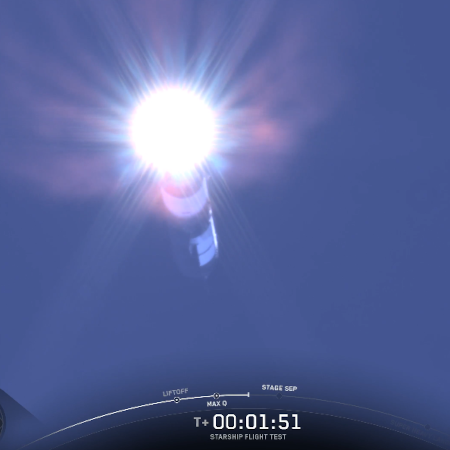
Starship and Superheavy during ascent today.
On the eleventh orbital test flight today of Starship/Superheavy, SpaceX basically achieved all its engineering goals, with both Superheavy and Starship completing their flights as planned, with Superheavy doing a soft vertical splashdown in the Gulf of Mexico, and Starship doing a soft vertical splashdown in the Indian Ocean.
The Superheavy flown was on its second flight, having flown on test flight #8. Of its 33 Raptor engines, 24 had flown previously. In returning, it successfully used a new configuration of engine burns, first firing thirteen engines, then six, then three.
More significant was Starship’s flight. The engineers had purposely left tiles off in some locations that would experience the greatest heat during re-entry, to find out if the ship could survive a loss of those tiles. It did, and did so in a truly remarkable manner, always flying in a controlled manner, even as it attempted a radical and previously untried banking maneuver as it approached the ocean in order to simulate a return to the launch tower chopsticks at Boca Chica.
Prior to splashdown and during its coast phase, Starship once again successfully tested the deployment of eight dummy Starlink satellites, as well as a relight of one of its Raptor engines to demonstrate it will be able to do a planned de-orbit burn once it enters a full orbit on future test flights.
Once again, the word to describe this flight is remarkable. While no else has yet been able to recover a first stage and reuse it, SpaceX has been doing it with its Falcon 9 for almost a decade, and doing it hundreds of times.
And now it has twice reused a Superheavy booster, out of only eleven test launches. Based on this and the last test flight, the company will almost certainly begin reusing Starship prototypes during next year’s orbital test flights, when it will begin flying full orbits using its third version of Starship, including returns to Boca Chica for chopstick tower catches. Furthermore, expect the deployment of real Starlink satellites on those missions.
The next mission should likely take place close to the end of this year, and it should likely be followed by additional flights about every two months.

“Proclaim liberty throughout all the land unto all
the inhabitants thereof.” Photo credit: William Zhang
While politicians and media swamp creatures focus on the relatively inconsequential race to do an Apollo-like manned landing on the Moon, the real American space program is being run privately by SpaceX, and its goal is to not only go to Mars, but to do so in a manner that will quickly establish a human colony. Along the way the company will help facilitate that government space program, but only as it helps SpaceX learn better how to get humans to Mars.
Most significantly, SpaceX is doing its space program entirely on its own dime. It is being financed by the revenues coming in to the company from the now more than seven million subscribers to Starlink. And those numbers will only rise with time, as Starship begins launching the next generation of satellites with capabilities that will dwarf all of SpaceX’s competitors.
Once again, freedom, private enterprise, and the American dream wins. May all humans someday live under rules that will allow them the same possibilities.
Germany’s space agency DLR delivers one prototype leg for Europe’s Callisto grasshopper
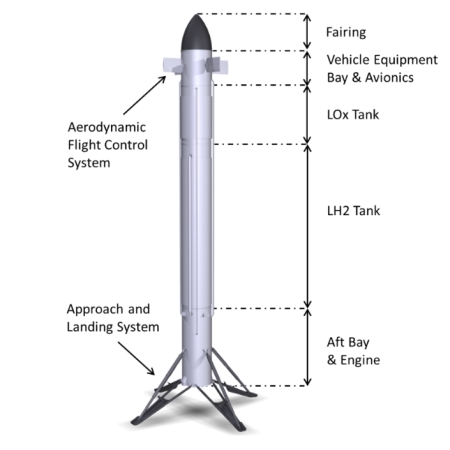
Callisto’s basic design
Government in-action: After a decade of work, the German space agency DLR this week finally delivered for testing a prototype leg of the Callisto grasshopper-type demo rocket, intended by the European Space Agency (ESA) to demonstrate vertical take-off and landing.
On 9 October, the Institute of Structures and Design announced that it had delivered a qualification model of the demonstrator’s landing leg to the Institute of Space Systems in Bremen. According to a 3 December 2024 update, the leg will now undergo a series of tests at the Institute’s Landing and Mobility Facility, including deployment, touchdown, and vibration testing.
Once the qualification test campaign is complete and the landing leg design has been validated, the Institute of Structures and Design will proceed with the construction of the four flight-ready legs.
Note again that Callisto, as shown to the right, was proposed as a joint ESA and JAXA project in 2015. Only now, a decade later, as DLR delivered one prototype leg. The first test hop has been repeatedly delayed, so that now it is now not expected to happen until 2027, and that rocket will not even be an operational version, it will simply be a small scale prototype.
Meanwhile, SpaceX has landed its Falcon 9 first stage hundreds of times, and reused them dozens of times. Other companies are flying or building their own reusable rockets, and hope to fly operational versions next year.
The contrast between this government project and the private sector is quite embarrassing. What makes it even more embarrassing is that it is par for the course, and yet so many people still look to the government as the god who can get things done. When will people learn?

Callisto’s basic design
Government in-action: After a decade of work, the German space agency DLR this week finally delivered for testing a prototype leg of the Callisto grasshopper-type demo rocket, intended by the European Space Agency (ESA) to demonstrate vertical take-off and landing.
On 9 October, the Institute of Structures and Design announced that it had delivered a qualification model of the demonstrator’s landing leg to the Institute of Space Systems in Bremen. According to a 3 December 2024 update, the leg will now undergo a series of tests at the Institute’s Landing and Mobility Facility, including deployment, touchdown, and vibration testing.
Once the qualification test campaign is complete and the landing leg design has been validated, the Institute of Structures and Design will proceed with the construction of the four flight-ready legs.
Note again that Callisto, as shown to the right, was proposed as a joint ESA and JAXA project in 2015. Only now, a decade later, as DLR delivered one prototype leg. The first test hop has been repeatedly delayed, so that now it is now not expected to happen until 2027, and that rocket will not even be an operational version, it will simply be a small scale prototype.
Meanwhile, SpaceX has landed its Falcon 9 first stage hundreds of times, and reused them dozens of times. Other companies are flying or building their own reusable rockets, and hope to fly operational versions next year.
The contrast between this government project and the private sector is quite embarrassing. What makes it even more embarrassing is that it is par for the course, and yet so many people still look to the government as the god who can get things done. When will people learn?
Watch the eleventh orbital test flight of SpaceX’s Starship/Superheavy rocket
The eleventh orbital test launch of Starship/Superheavy is scheduled for 6:15 (Central) today. It will be the last flight for version 2 of Starship, and will also include the second reuse of a Superheavy booster.
Starship will repeat its flight plan from the previous flight, testing the deployment of dummy Starlink satellites, the relighting of its Raptor engines once in orbit, and various new configurations of its thermal protection system. It will come down in the Indian Ocean, either controlled or not. Future flights will use version three, and quickly move towards orbital flights and a return to Boca Chica for a tower chopstick capture and later reuse.
Superheavy, which flew previously on the eighth test flight, will do more engine configuration tests on its return, and will attempt a soft vertical splashdown in the Gulf.
You can watch SpaceX’s X live stream at the link above. I have also embedded Space Affairs youtube feed below.
» Read more
The eleventh orbital test launch of Starship/Superheavy is scheduled for 6:15 (Central) today. It will be the last flight for version 2 of Starship, and will also include the second reuse of a Superheavy booster.
Starship will repeat its flight plan from the previous flight, testing the deployment of dummy Starlink satellites, the relighting of its Raptor engines once in orbit, and various new configurations of its thermal protection system. It will come down in the Indian Ocean, either controlled or not. Future flights will use version three, and quickly move towards orbital flights and a return to Boca Chica for a tower chopstick capture and later reuse.
Superheavy, which flew previously on the eighth test flight, will do more engine configuration tests on its return, and will attempt a soft vertical splashdown in the Gulf.
You can watch SpaceX’s X live stream at the link above. I have also embedded Space Affairs youtube feed below.
» Read more
Rocket Lab gets two-launch contract from Japan’s space agency JAXA
In what appears to be a significant slap at its own rockets (especially its delayed Epsilon-S rocket), Japan’s space agency JAXA this week signed a two-launch deal with the American rocket company Rocket Lab.
Launching from Rocket Lab Launch Complex 1 in New Zealand, the two Electron missions will deploy satellites for JAXA’s Innovative Satellite Technology Demonstration Program. The first launch, scheduled from December 2025, will deploy the agency’s RApid Innovative payload demonstration SatellitE-4 (RAISE-4) spacecraft, a single satellite that will demonstrate eight technologies developed by private companies, universities, and research institutions throughout Japan.
The second launch, scheduled for 2026, is a JAXA-manifested rideshare of eight separate spacecraft that includes educational small sats, an ocean monitoring satellite, a demonstration satellite for ultra-small multispectral cameras, and a deployable antenna that can be packed tightly using origami folding techniques and unfurled to 25 times its size.
Rocket Lab has previously won contracts from several private Japanese satellite companies (Q-Shu, Astroscale, ALE), but this I think is the first JAXA contract it has won. What makes it significant is that JAXA has always focused on using its own rockets, the large retired H2A and the new H3 as well as the smaller Epsilon-S. To go to an American company is somewhat unprecedented.
Though larger than Rocket Lab’s Electron rocket, Epsilon-S was being developed to compete for the same market. That development however has been plagued by failure, including explosions of engines during tests of both its upper and first stages in ’23 and ’24 respectively. After the second explosion JAXA announced in December 2024 the rocket’s first launch would not occur in the spring of 2025 as planned, but provided no additional information. Since then there have been no updates.
This Rocket Lab deal suggests the Epsilon program is in big trouble. In the long run however this might be a very good thing for both JAXA and Japan’s own nascent rocket industry. JAXA might finally be recognizing that building and owning its own rockets is not the best plan, that it would be better to use the capitalism model and simply be a customer buying the services from the private sector. At the moment Japan doesn’t yet have a viable commercial rocket sector, with only Mitsubishi having an operational commercial rocket, the H3 (mostly controlled by JAXA). There are a number of new startups however, including Interstellar, Honda, Space One, and Tispace, all of which have done tests of one kind or another. If JAXA is ready to abandon its own government rockets and buy the service from the private sector, those Japanese startups will start to prosper.
In what appears to be a significant slap at its own rockets (especially its delayed Epsilon-S rocket), Japan’s space agency JAXA this week signed a two-launch deal with the American rocket company Rocket Lab.
Launching from Rocket Lab Launch Complex 1 in New Zealand, the two Electron missions will deploy satellites for JAXA’s Innovative Satellite Technology Demonstration Program. The first launch, scheduled from December 2025, will deploy the agency’s RApid Innovative payload demonstration SatellitE-4 (RAISE-4) spacecraft, a single satellite that will demonstrate eight technologies developed by private companies, universities, and research institutions throughout Japan.
The second launch, scheduled for 2026, is a JAXA-manifested rideshare of eight separate spacecraft that includes educational small sats, an ocean monitoring satellite, a demonstration satellite for ultra-small multispectral cameras, and a deployable antenna that can be packed tightly using origami folding techniques and unfurled to 25 times its size.
Rocket Lab has previously won contracts from several private Japanese satellite companies (Q-Shu, Astroscale, ALE), but this I think is the first JAXA contract it has won. What makes it significant is that JAXA has always focused on using its own rockets, the large retired H2A and the new H3 as well as the smaller Epsilon-S. To go to an American company is somewhat unprecedented.
Though larger than Rocket Lab’s Electron rocket, Epsilon-S was being developed to compete for the same market. That development however has been plagued by failure, including explosions of engines during tests of both its upper and first stages in ’23 and ’24 respectively. After the second explosion JAXA announced in December 2024 the rocket’s first launch would not occur in the spring of 2025 as planned, but provided no additional information. Since then there have been no updates.
This Rocket Lab deal suggests the Epsilon program is in big trouble. In the long run however this might be a very good thing for both JAXA and Japan’s own nascent rocket industry. JAXA might finally be recognizing that building and owning its own rockets is not the best plan, that it would be better to use the capitalism model and simply be a customer buying the services from the private sector. At the moment Japan doesn’t yet have a viable commercial rocket sector, with only Mitsubishi having an operational commercial rocket, the H3 (mostly controlled by JAXA). There are a number of new startups however, including Interstellar, Honda, Space One, and Tispace, all of which have done tests of one kind or another. If JAXA is ready to abandon its own government rockets and buy the service from the private sector, those Japanese startups will start to prosper.
China launches three satellites from ocean platform
The Chinese pseudo-company Orienspace yesterday successfully placed three satellites into orbit, its solid-fueled Gravity-1 rocket lifting off from an ocean platform off the country’s northeast coast.
This was Orienspace’s second launch, both using its Gravity-1 rocket from the ocean. Of the three satellites, one was an Earth observation satellite, and the other two were part of the pseudo-company Geespace’s Geely constellation of satellites, though it is not clear if these are for its Internet-of-Things (IoT) constellation or for general communications. The IoT constellation already has 64 satellites in orbit out of a planned 240.
Another launch of China’s Long March 8A rocket was supposed to happen yesterday, but there is no indication in China’s state-run that it took place, nor any information about a rescheduled launch date. That state-run press also illustrated the pseudo nature of these Chinese companies by only mentioning Orienspace as an afterthought at the end of the article.
The leaders in the 2025 launch race:
129 SpaceX
59 China
13 Russia
12 Rocket Lab
SpaceX still leads the rest of the world in successful launches, 129 to 99. The company will try again this evening to launch its third mission for Amazon, placing a set of Kuiper satellites into orbit. Weather has scrubbed the past two attempts in the previous few days.
The Chinese pseudo-company Orienspace yesterday successfully placed three satellites into orbit, its solid-fueled Gravity-1 rocket lifting off from an ocean platform off the country’s northeast coast.
This was Orienspace’s second launch, both using its Gravity-1 rocket from the ocean. Of the three satellites, one was an Earth observation satellite, and the other two were part of the pseudo-company Geespace’s Geely constellation of satellites, though it is not clear if these are for its Internet-of-Things (IoT) constellation or for general communications. The IoT constellation already has 64 satellites in orbit out of a planned 240.
Another launch of China’s Long March 8A rocket was supposed to happen yesterday, but there is no indication in China’s state-run that it took place, nor any information about a rescheduled launch date. That state-run press also illustrated the pseudo nature of these Chinese companies by only mentioning Orienspace as an afterthought at the end of the article.
The leaders in the 2025 launch race:
129 SpaceX
59 China
13 Russia
12 Rocket Lab
SpaceX still leads the rest of the world in successful launches, 129 to 99. The company will try again this evening to launch its third mission for Amazon, placing a set of Kuiper satellites into orbit. Weather has scrubbed the past two attempts in the previous few days.
New research confirms the steady decline of Martian ice with each glacial cycle
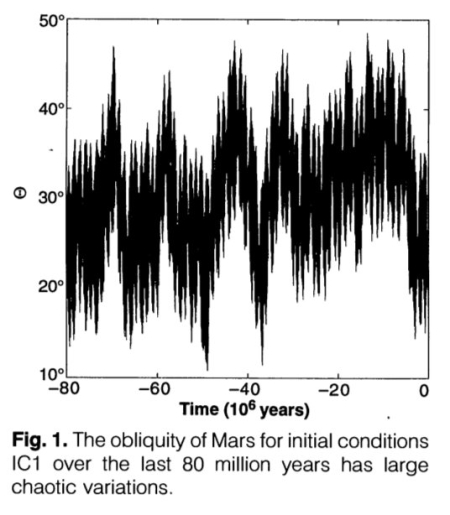
Using orbital data from Mars Reconnaissance Orbiter (MRO) of glaciers inside mid-latitude craters, scientists have concluded that there was a steady decline in the growth of those glaciers with each new glacial cycle.
They focused on craters with indicative signs of glaciation, such as ridges, moraines (piles of debris left behind by glaciers), and brain terrain (a pitted, maze-like surface formed by ice-rich landforms). By comparing the shapes and orientations of these features with climate models, they found that ice consistently clustered in the colder, shadowed southwestern walls of craters. This trend was consistent across various glacial periods, ranging from approximately 640 million to 98 million years ago.
The results show that Mars didn’t just freeze once—it went through a series of ice ages driven by shifts in its axial tilt, also known as obliquity. Unlike Earth, Mars’ tilt can swing dramatically over millions of years, redistributing sunlight and triggering cycles of ice build-up and melting. These changes shaped where water ice could survive on the planet’s surface. Over time, however, each cycle stored less ice, pointing to a gradual planetary drying. [emphasis mine]
You can read the paper here [pdf]. This result is not new. Based on the orbital data scientists have theorized now for almost a decade that as Mars’ rotational tilt (its obliquity) swings from 11 to 60 degrees, it produces extreme climate cycles on the planet. Those swings are shown on the graph to the right, taken from this 1993 paper [pdf]. When the obliquity is low, the mid-latitudes are warm and the glaciers there shrink, with the snow falling at the poles. When obliquity is high, the poles are warmer and its ice sublimates away to fall as snow in the mid-latitudes, thus causing those glaciers to grow instead.
The orbital data has consistently shown that with each new cycle, the glaciers grew less, suggesting that less global water was available on the planet. This new study further confirms these conclusions.
One last point: Though the amount of water ice on Mars has declined, we mustn’t think the red planet now has none. The orbital data shows that there is a lot of near surface ice on Mars, covering the planet from 30 degrees latitude poleward. As I’ve noted numerous times, Mars is a desert like Antarctica.

Using orbital data from Mars Reconnaissance Orbiter (MRO) of glaciers inside mid-latitude craters, scientists have concluded that there was a steady decline in the growth of those glaciers with each new glacial cycle.
They focused on craters with indicative signs of glaciation, such as ridges, moraines (piles of debris left behind by glaciers), and brain terrain (a pitted, maze-like surface formed by ice-rich landforms). By comparing the shapes and orientations of these features with climate models, they found that ice consistently clustered in the colder, shadowed southwestern walls of craters. This trend was consistent across various glacial periods, ranging from approximately 640 million to 98 million years ago.
The results show that Mars didn’t just freeze once—it went through a series of ice ages driven by shifts in its axial tilt, also known as obliquity. Unlike Earth, Mars’ tilt can swing dramatically over millions of years, redistributing sunlight and triggering cycles of ice build-up and melting. These changes shaped where water ice could survive on the planet’s surface. Over time, however, each cycle stored less ice, pointing to a gradual planetary drying. [emphasis mine]
You can read the paper here [pdf]. This result is not new. Based on the orbital data scientists have theorized now for almost a decade that as Mars’ rotational tilt (its obliquity) swings from 11 to 60 degrees, it produces extreme climate cycles on the planet. Those swings are shown on the graph to the right, taken from this 1993 paper [pdf]. When the obliquity is low, the mid-latitudes are warm and the glaciers there shrink, with the snow falling at the poles. When obliquity is high, the poles are warmer and its ice sublimates away to fall as snow in the mid-latitudes, thus causing those glaciers to grow instead.
The orbital data has consistently shown that with each new cycle, the glaciers grew less, suggesting that less global water was available on the planet. This new study further confirms these conclusions.
One last point: Though the amount of water ice on Mars has declined, we mustn’t think the red planet now has none. The orbital data shows that there is a lot of near surface ice on Mars, covering the planet from 30 degrees latitude poleward. As I’ve noted numerous times, Mars is a desert like Antarctica.
Orbital tug company Momentus gets two NASA contracts
The orbital tug startup Momentus yesterday announced that NASA has awarded it two contracts worth $7.6 million total to fly two experimental NASA payloads on its Vigoride tug.
One payload will test “test the ability to make semiconductor crystals in microgravity”, while the second will “test a rotating detonation rocket engine, a propulsion system designed to provide higher efficiency than traditional engines.” In this case the propellants used will be nitrous oxide and ethane.
Both will fly on the same Vigoride tug on a mission to be launched no earlier than October 2026. Momentus also says there is room for additional payloads on that mission.
It appears the increase in the number and launches of rockets has actually hurt the orbital tug business:
Momentus is among several companies that developed orbital transfer vehicles, or OTVs, like Vigoride to ferry spacecraft between orbits. They are designed to provide last-mile delivery to specific orbits for spacecraft launched on rideshare missions such as [SpaceX’s] Transporter [launches]. However, demand for such services has been slower to materialize than expected. “Candidly, that part of the market has not developed as much as people thought, say, five years ago,” [said John Rood, Momentus’ chief executive] during a panel at World Space Business Week in September. “The reason is many small manufacturers are multi-manifesting satellites to deploy a single plane with a single launcher.”
As a result, Momentus has focused on getting technology demonstration contracts such as the two above, with the tug acting more like a service module.
The orbital tug startup Momentus yesterday announced that NASA has awarded it two contracts worth $7.6 million total to fly two experimental NASA payloads on its Vigoride tug.
One payload will test “test the ability to make semiconductor crystals in microgravity”, while the second will “test a rotating detonation rocket engine, a propulsion system designed to provide higher efficiency than traditional engines.” In this case the propellants used will be nitrous oxide and ethane.
Both will fly on the same Vigoride tug on a mission to be launched no earlier than October 2026. Momentus also says there is room for additional payloads on that mission.
It appears the increase in the number and launches of rockets has actually hurt the orbital tug business:
Momentus is among several companies that developed orbital transfer vehicles, or OTVs, like Vigoride to ferry spacecraft between orbits. They are designed to provide last-mile delivery to specific orbits for spacecraft launched on rideshare missions such as [SpaceX’s] Transporter [launches]. However, demand for such services has been slower to materialize than expected. “Candidly, that part of the market has not developed as much as people thought, say, five years ago,” [said John Rood, Momentus’ chief executive] during a panel at World Space Business Week in September. “The reason is many small manufacturers are multi-manifesting satellites to deploy a single plane with a single launcher.”
As a result, Momentus has focused on getting technology demonstration contracts such as the two above, with the tug acting more like a service module.
Astronomers take first radio image of the supermassive binary system OJ287
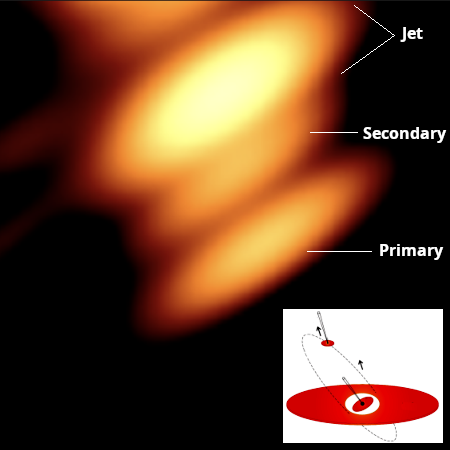
Using archive data from the now retired Russian orbiting radio telescope RadioAstron, scientists have now obtained the first image of the binary supermassive black hole system OJ287 that was previously detected flaring as predicted when the smaller black hole (150 million solar masses) circled near the larger (18 billion solar masses).
That image is to the right, cropped and annotated to post here. The cartoon in the lower right shows the theorized orientation of the system, taken from figure 2 of the published paper [pdf]. According to the paper the elongation of the three objects is an artifact of the data and is “not real.” From the press release:
In this latest study, the astronomers compared the earlier theoretical calculations with a radio image. The two black holes were there in the image, just where they were expected to be. This gave the researchers an answer to a question that has been open for 40 years: whether black-hole pairs exist in the first place. “For the first time, we managed to get an image of two black holes circling each other. In the image, the black holes are identified by the intense particle jets they emit. The black holes themselves are perfectly black, but they can be detected by these particle jets or by the glowing gas surrounding the hole,” Valtonen says.
The researchers also identified a completely new kind of a jet emanating from a black hole. The jet coming out of the smaller black hole is twisted like a jet of a rotating garden hose. This is because the smaller black hole moves fast around the primary black hole of OJ287, and its jet is diverted depending on its current motion. The researches liken it to “a wagging tail” which should be seen twisting in different directions in the coming years when the smaller black hole changes its speed and direction of motion.
This image is cropped from the full dataset. The jet continues upward and then curves to the right as it “wags” away.
This incredible black hole binary system, estimated to be about 3.5 billion light years away, has been posited since 1982, when one astronomer noticed that it repeatedly flared every twelve years. Since then scientists have successfully predicted several flares, based on the system’s theorized orbit. These images further confirm the system’s shape.

Using archive data from the now retired Russian orbiting radio telescope RadioAstron, scientists have now obtained the first image of the binary supermassive black hole system OJ287 that was previously detected flaring as predicted when the smaller black hole (150 million solar masses) circled near the larger (18 billion solar masses).
That image is to the right, cropped and annotated to post here. The cartoon in the lower right shows the theorized orientation of the system, taken from figure 2 of the published paper [pdf]. According to the paper the elongation of the three objects is an artifact of the data and is “not real.” From the press release:
In this latest study, the astronomers compared the earlier theoretical calculations with a radio image. The two black holes were there in the image, just where they were expected to be. This gave the researchers an answer to a question that has been open for 40 years: whether black-hole pairs exist in the first place. “For the first time, we managed to get an image of two black holes circling each other. In the image, the black holes are identified by the intense particle jets they emit. The black holes themselves are perfectly black, but they can be detected by these particle jets or by the glowing gas surrounding the hole,” Valtonen says.
The researchers also identified a completely new kind of a jet emanating from a black hole. The jet coming out of the smaller black hole is twisted like a jet of a rotating garden hose. This is because the smaller black hole moves fast around the primary black hole of OJ287, and its jet is diverted depending on its current motion. The researches liken it to “a wagging tail” which should be seen twisting in different directions in the coming years when the smaller black hole changes its speed and direction of motion.
This image is cropped from the full dataset. The jet continues upward and then curves to the right as it “wags” away.
This incredible black hole binary system, estimated to be about 3.5 billion light years away, has been posited since 1982, when one astronomer noticed that it repeatedly flared every twelve years. Since then scientists have successfully predicted several flares, based on the system’s theorized orbit. These images further confirm the system’s shape.
Canadian rocket startup Nordspace signs deal for its mission control center

Proposed Canadian spaceports
The Canadian rocket startup Nordspace, which earlier this week signed a deal for another company to establish ground stations for its proposed Atlantic Spaceport, today signed an agreement with the company Kongsberg Geospatial to provide software for running its mission control center.
According to the news release TerraLens “will ingest data from multiple sensors to deliver real-time three-dimensional (3D) visualization of launch operations, range safety, decision support, and vehicle tracking. This will help streamline launch operations and enable deployment of critical space missions to orbit in under 48 hours.” Kongsberg said TerraLens builds on their “experience supporting range safety and mission-critical visualization for the Andøya Space and Defence project in Norway.”
Andøya is Norway’s new commercial spaceport that has been launching suborbital government rockets for decades.
Nordspace continues to move forward quickly, having been established only three years ago. It is putting the pieces together for its spaceport, and is testing both a small suborbital rocket and the engines for its proposed orbital Tundra rocket. Though the race is certainly not over, it does appear Nordspace will get to orbit ahead of the Nova Scotia spaceport that was first proposed in 2016.

Proposed Canadian spaceports
The Canadian rocket startup Nordspace, which earlier this week signed a deal for another company to establish ground stations for its proposed Atlantic Spaceport, today signed an agreement with the company Kongsberg Geospatial to provide software for running its mission control center.
According to the news release TerraLens “will ingest data from multiple sensors to deliver real-time three-dimensional (3D) visualization of launch operations, range safety, decision support, and vehicle tracking. This will help streamline launch operations and enable deployment of critical space missions to orbit in under 48 hours.” Kongsberg said TerraLens builds on their “experience supporting range safety and mission-critical visualization for the Andøya Space and Defence project in Norway.”
Andøya is Norway’s new commercial spaceport that has been launching suborbital government rockets for decades.
Nordspace continues to move forward quickly, having been established only three years ago. It is putting the pieces together for its spaceport, and is testing both a small suborbital rocket and the engines for its proposed orbital Tundra rocket. Though the race is certainly not over, it does appear Nordspace will get to orbit ahead of the Nova Scotia spaceport that was first proposed in 2016.
Saturn as seen by Cassini in 2004, four months before orbital insertion
Cool image time! As most of the new cool images coming down from space seem mostly limited to Mars and deep space astronomy, I decided today to dig into the archive of the probe Cassini, which orbited Saturn from July 1, 2004 until September 15, 2017, when it was sent plunging into the gas giant’s atmosphere.
The picture to the right heralded the start of that mission, in that it was taken on February 19, 2004, a little over four months before the spacecraft fired its engines and entered orbit. I have rotated the image and cropped it to post here.
When Cassini snapped this picture it was just approaching the gas giant. The image itself is relatively small, with the resolution also relatively poor. You can see one of Saturn’s moons above the planet, but I can’t tell you which one. As noted at the webpage, this is a raw image that has not been “validated or calibrated.”
While not up to the amazing standard exhibited by Cassini’s images during its thirteen year stay at Saturn, it gave us a flavor of the wonders to come. Of all the planets, Saturn might be the most beautiful.
Cool image time! As most of the new cool images coming down from space seem mostly limited to Mars and deep space astronomy, I decided today to dig into the archive of the probe Cassini, which orbited Saturn from July 1, 2004 until September 15, 2017, when it was sent plunging into the gas giant’s atmosphere.
The picture to the right heralded the start of that mission, in that it was taken on February 19, 2004, a little over four months before the spacecraft fired its engines and entered orbit. I have rotated the image and cropped it to post here.
When Cassini snapped this picture it was just approaching the gas giant. The image itself is relatively small, with the resolution also relatively poor. You can see one of Saturn’s moons above the planet, but I can’t tell you which one. As noted at the webpage, this is a raw image that has not been “validated or calibrated.”
While not up to the amazing standard exhibited by Cassini’s images during its thirteen year stay at Saturn, it gave us a flavor of the wonders to come. Of all the planets, Saturn might be the most beautiful.
AST SpaceMobile signs up Verizon to use its constellation for phone-to-satellite service
The startup AST SpaceMobile, which is building a constellation of satellites able to act as cell towers for smart phones, has now signed an agreement with Verizon to give its subscribers access to the service.
AST SpaceMobile’s shares closed up more than 8% Oct. 8 after Verizon joined AT&T in signing a definitive agreement to use its planned space-based cellular network, easing investor concerns about SpaceX’s aggressive push into the fledgling direct-to-device (D2D) market.
The deal enables Verizon to provide D2D connectivity to its customers from some point in 2026, building on a strategic partnership announced in May 2024 that included plans for a $100 million investment in AST.
As noted above, AST has now signed both Verizon and AT&T, two of the largest cellphone companies, strengthening its position considerably in its competition with SpaceX’s Starlink cell-to-satellite alternative. Both deals appear to allow these companies the ability to sign contracts with both AST and Starlink, so it is possible the competition won’t be as fierce initially as it appears. It is also possible that eventually they will pick one or the other, so neither company should be complacent.
AST presently has five of its BlueBird satellites in orbit out of its planned 45-60 satellite constellation, and hopes to have at least half the constellation in orbit by the end of ’26. So even if it wins its cellphone competition with SpaceX that rocket company will still likely make some money launching AST’s satellites.
The startup AST SpaceMobile, which is building a constellation of satellites able to act as cell towers for smart phones, has now signed an agreement with Verizon to give its subscribers access to the service.
AST SpaceMobile’s shares closed up more than 8% Oct. 8 after Verizon joined AT&T in signing a definitive agreement to use its planned space-based cellular network, easing investor concerns about SpaceX’s aggressive push into the fledgling direct-to-device (D2D) market.
The deal enables Verizon to provide D2D connectivity to its customers from some point in 2026, building on a strategic partnership announced in May 2024 that included plans for a $100 million investment in AST.
As noted above, AST has now signed both Verizon and AT&T, two of the largest cellphone companies, strengthening its position considerably in its competition with SpaceX’s Starlink cell-to-satellite alternative. Both deals appear to allow these companies the ability to sign contracts with both AST and Starlink, so it is possible the competition won’t be as fierce initially as it appears. It is also possible that eventually they will pick one or the other, so neither company should be complacent.
AST presently has five of its BlueBird satellites in orbit out of its planned 45-60 satellite constellation, and hopes to have at least half the constellation in orbit by the end of ’26. So even if it wins its cellphone competition with SpaceX that rocket company will still likely make some money launching AST’s satellites.
Martian winds are faster than expected
According to an analysis of pairs of 300 hundred orbital images taken seconds apart, scientist have found that Martian winds can reach speeds of 100 miles per hour (160 kilometers per hours), much faster than previously expected.
The results show that the dust devils and the winds surrounding them on Mars can reach speeds of up to 44 m/s, i.e. around 160 km/h, across the entire planet, which is much faster than previously assumed (previous measurements on the surface had shown that winds mostly remain below 50 km/h and – in rare cases – can reach a maximum of 100 km/h). The high wind speed in turn influences the dust cycle on the Red Planet: “These strong, straight-line winds are very likely to bring a considerable amount of dust into the Martian atmosphere – much more than previously assumed,” says Bickel. He continues: “Our data show where and when the winds on Mars seem to be strong enough to lift dust from the surface. This is the first time that such findings are available on a global scale for a period of around two decades.”
You can read the paper here. The study also found dust devils favor the spring and summer in both the north and south hemispheres, and tended to be concentrated in the mid-latitudes.
What is most interesting about this data, which because it is somewhat sparse has a lot of uncertainties, is that it suggests the candidate landing zone for SpaceX’s Starship is a region with one of the most intense dust devil seasons every spring and summer. This is not really a threat to settlement, because the atmosphere is so thin even these high winds would hardly be felt, but it does indicate an environmental condition that must be considered for any future settlement there.
According to an analysis of pairs of 300 hundred orbital images taken seconds apart, scientist have found that Martian winds can reach speeds of 100 miles per hour (160 kilometers per hours), much faster than previously expected.
The results show that the dust devils and the winds surrounding them on Mars can reach speeds of up to 44 m/s, i.e. around 160 km/h, across the entire planet, which is much faster than previously assumed (previous measurements on the surface had shown that winds mostly remain below 50 km/h and – in rare cases – can reach a maximum of 100 km/h). The high wind speed in turn influences the dust cycle on the Red Planet: “These strong, straight-line winds are very likely to bring a considerable amount of dust into the Martian atmosphere – much more than previously assumed,” says Bickel. He continues: “Our data show where and when the winds on Mars seem to be strong enough to lift dust from the surface. This is the first time that such findings are available on a global scale for a period of around two decades.”
You can read the paper here. The study also found dust devils favor the spring and summer in both the north and south hemispheres, and tended to be concentrated in the mid-latitudes.
What is most interesting about this data, which because it is somewhat sparse has a lot of uncertainties, is that it suggests the candidate landing zone for SpaceX’s Starship is a region with one of the most intense dust devil seasons every spring and summer. This is not really a threat to settlement, because the atmosphere is so thin even these high winds would hardly be felt, but it does indicate an environmental condition that must be considered for any future settlement there.
Fresh slope streak on Mars

For original images go here and here.
Cool image time! One of the geological mysteries on Mars seen no where on Earth is something scientists have dubbed “slope streaks.” Though they at first glance appear to be avalanches, they do nothing to change the topography, have no debris pile at their base, and sometimes even travel up and over rises on their way downhill. They can also appear randomly throughout the year, can be bright or dark, and fade with time.
No theory as to their cause has yet been accepted, though recent research suggests they are dry events, dust avalanches triggered by dust devils, wind, or the accumulation of dust.
To better understand this geology, scientists repeatedly monitor known slope streak locations looking for changes. The two images to the right are an example, downloaded from the high resolution camera on Mars Reconnaissance Orbiter (MRO) on July 2, 2024 and September 1, 2025. In the fourteen months that passed between the first and second images, two distinct and large slope streaks occurred next to each other, near the bottom of the picture. All the other streaks merely faded.
» Read more

For original images go here and here.
Cool image time! One of the geological mysteries on Mars seen no where on Earth is something scientists have dubbed “slope streaks.” Though they at first glance appear to be avalanches, they do nothing to change the topography, have no debris pile at their base, and sometimes even travel up and over rises on their way downhill. They can also appear randomly throughout the year, can be bright or dark, and fade with time.
No theory as to their cause has yet been accepted, though recent research suggests they are dry events, dust avalanches triggered by dust devils, wind, or the accumulation of dust.
To better understand this geology, scientists repeatedly monitor known slope streak locations looking for changes. The two images to the right are an example, downloaded from the high resolution camera on Mars Reconnaissance Orbiter (MRO) on July 2, 2024 and September 1, 2025. In the fourteen months that passed between the first and second images, two distinct and large slope streaks occurred next to each other, near the bottom of the picture. All the other streaks merely faded.
» Read more
Canadian rocket startup Nordspace obtains expanded ground station contract

Proposed Canadian spaceports
The Canadian rocket startup Nordspace has signed an agreement with the ground station company C-Core to establish more tracking and communication facilities in conjunction with Nordspace’s launch plans at its Atlantic spaceport in Newfoundland.
NordSpace and C-CORE have signed a Memorandum of Understanding (MOU) that will see the companies work together in developing new ground stations across Canada with initial locations planned for the Atlantic Spaceport Complex (ASX) in St. Lawrence, Newfoundland and Labrador, and Inuvik, Northwest Territories.
With C-CORE being based in St. John’s, Newfoundland, and already established in providing ground station services, it seems like a natural collaboration that could benefit both companies. For NordSpace, which owns and is developing the Atlantic Spaceport Complex, this collaboration provides the potential for another type of revenue source as the company tries to diversify.
Nordspace has not yet launched, though its first suborbital test launch several weeks ago was scrubbed twice due to ground equipment fuel leaks. It has not yet announced another date for that suborbital test, but plans a static fire test in October of the engine it is building for its orbital Tundra rocket.
This company is only three years old, and appears to have leap-frogged past Canada’s other spaceport operation in Nova Scotia, which has been trying to get off the ground for almost a decade.

Proposed Canadian spaceports
The Canadian rocket startup Nordspace has signed an agreement with the ground station company C-Core to establish more tracking and communication facilities in conjunction with Nordspace’s launch plans at its Atlantic spaceport in Newfoundland.
NordSpace and C-CORE have signed a Memorandum of Understanding (MOU) that will see the companies work together in developing new ground stations across Canada with initial locations planned for the Atlantic Spaceport Complex (ASX) in St. Lawrence, Newfoundland and Labrador, and Inuvik, Northwest Territories.
With C-CORE being based in St. John’s, Newfoundland, and already established in providing ground station services, it seems like a natural collaboration that could benefit both companies. For NordSpace, which owns and is developing the Atlantic Spaceport Complex, this collaboration provides the potential for another type of revenue source as the company tries to diversify.
Nordspace has not yet launched, though its first suborbital test launch several weeks ago was scrubbed twice due to ground equipment fuel leaks. It has not yet announced another date for that suborbital test, but plans a static fire test in October of the engine it is building for its orbital Tundra rocket.
This company is only three years old, and appears to have leap-frogged past Canada’s other spaceport operation in Nova Scotia, which has been trying to get off the ground for almost a decade.
Stoke Space said to be raising as much as $500 million in private investment capital
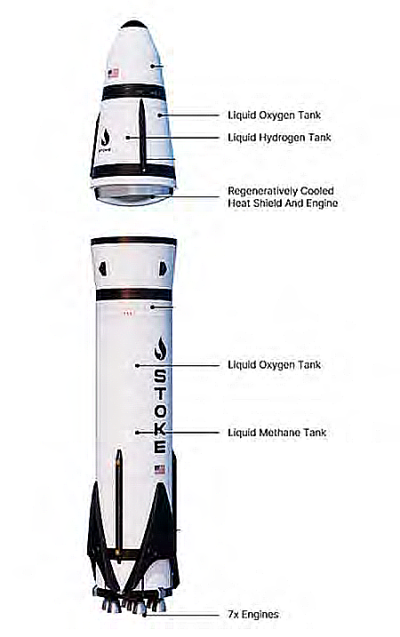
Stoke’s Nova rocket, designed to be
completely reusable.
UPDATE: Stoke Space confirms the story, announcing today that it has raised $510 million in new capital.
According to anonymous sources, the rocket startup Stoke Space is in the process of raising as much as $500 million in private investment capital, with new $2 billion valuation for the company.
Stoke Space, one of the Seattle area’s up-and-coming space startups, is said to be raising hundreds of millions of dollars in a funding round that it hasn’t yet publicly acknowledged. A report about the round, based on two unidentified sources, was published today by The Information.
The Information quoted its sources as saying that the funding round could total as much as $500 million, and would value Stoke at nearly $2 billion. That figure would be roughly twice as much as the $944 million valuation that was cited by Pitchbook as of January. The round’s lead investor is said to be Thomas Tull’s United States Innovative Technology Fund.
Earlier this year Stoke raised $260 million, bringing its available capital to almost a half billion. If this story is confirmed, it means the company will have almost a billion in available cash on hand.
The design of Stoke’s Nova rocket is unique in that both the lower and upper stages will be reusable. The first stage will land vertically, like SpaceX’s Falcon 9. The upper stage meanwhile uses a radical nozzle design, a ring of tiny nozzles around the perimeter of a heat shield, to protect it during re-entry.
The company has said it plans the first launch in 2026, but has not been more specific as to when. If successful, this rocket will certainly become a major player, as it will be able to offer even lower prices than SpaceX because none of the rocket will be expendable.

Stoke’s Nova rocket, designed to be
completely reusable.
UPDATE: Stoke Space confirms the story, announcing today that it has raised $510 million in new capital.
According to anonymous sources, the rocket startup Stoke Space is in the process of raising as much as $500 million in private investment capital, with new $2 billion valuation for the company.
Stoke Space, one of the Seattle area’s up-and-coming space startups, is said to be raising hundreds of millions of dollars in a funding round that it hasn’t yet publicly acknowledged. A report about the round, based on two unidentified sources, was published today by The Information.
The Information quoted its sources as saying that the funding round could total as much as $500 million, and would value Stoke at nearly $2 billion. That figure would be roughly twice as much as the $944 million valuation that was cited by Pitchbook as of January. The round’s lead investor is said to be Thomas Tull’s United States Innovative Technology Fund.
Earlier this year Stoke raised $260 million, bringing its available capital to almost a half billion. If this story is confirmed, it means the company will have almost a billion in available cash on hand.
The design of Stoke’s Nova rocket is unique in that both the lower and upper stages will be reusable. The first stage will land vertically, like SpaceX’s Falcon 9. The upper stage meanwhile uses a radical nozzle design, a ring of tiny nozzles around the perimeter of a heat shield, to protect it during re-entry.
The company has said it plans the first launch in 2026, but has not been more specific as to when. If successful, this rocket will certainly become a major player, as it will be able to offer even lower prices than SpaceX because none of the rocket will be expendable.
Japanese satellite company extends its launch contract with Rocket Lab
The Japanese satellite company Q-shu Pioneers of Space, Inc. (iQPS) has purchased three more launches from Rocket Lab, for a total of seven planned.
The multi-launch contract includes three dedicated Electron missions that will launch no earlier than 2026 from Rocket Lab Launch Complex 1 in New Zealand. With four dedicated missions already booked by iQPS on Electron, these three additional missions bring the total number of upcoming launches for iQPS to seven.
Each dedicated launch will deploy a single synthetic aperture radar (SAR) satellite from a Rocket Lab Motorized Lightband separation system – demonstrating Rocket Lab’s vertical integration across launch and space systems that improves reliability and streamlines the launch process for its customers.
Rocket Lab has already completed four successful launches for iOPS, so with this deal means that it will complete eleven launches total for the satellite company. Essentially iQPS has made Rocket Lab its prime launch provider.
This is also the second major launch contract for Rocket Lab in the past week. On September 30, 2025 Synspective purchased its second multi-launch contract with the company, buying ten more launches. Its first contract was for eleven launches, with six already completed. Synspective hopes to have its entire radar constellation of 30 satellites in orbit by the late 2020s.
Both contracts tell us that Rocket Lab’s Electron rocket is going to have a very busy launch schedule for the next few years, even as the company initiates its larger Neutron rocket.
The Japanese satellite company Q-shu Pioneers of Space, Inc. (iQPS) has purchased three more launches from Rocket Lab, for a total of seven planned.
The multi-launch contract includes three dedicated Electron missions that will launch no earlier than 2026 from Rocket Lab Launch Complex 1 in New Zealand. With four dedicated missions already booked by iQPS on Electron, these three additional missions bring the total number of upcoming launches for iQPS to seven.
Each dedicated launch will deploy a single synthetic aperture radar (SAR) satellite from a Rocket Lab Motorized Lightband separation system – demonstrating Rocket Lab’s vertical integration across launch and space systems that improves reliability and streamlines the launch process for its customers.
Rocket Lab has already completed four successful launches for iOPS, so with this deal means that it will complete eleven launches total for the satellite company. Essentially iQPS has made Rocket Lab its prime launch provider.
This is also the second major launch contract for Rocket Lab in the past week. On September 30, 2025 Synspective purchased its second multi-launch contract with the company, buying ten more launches. Its first contract was for eleven launches, with six already completed. Synspective hopes to have its entire radar constellation of 30 satellites in orbit by the late 2020s.
Both contracts tell us that Rocket Lab’s Electron rocket is going to have a very busy launch schedule for the next few years, even as the company initiates its larger Neutron rocket.
Martian boxwork on the flanks of Mount Sharp
Cool image time! The picture to the right, cropped, reduced, and sharpened to post here, was taken on October 5, 2025 by the left navigation camera on the Mars rover Curiosity.
The picture looks north and downhill from the lower flanks of Mount Sharp, inside Gale Crater. In the far distance on the horizon can be seen the crater’s northern rim, about 20 to 30 miles away. As it is now moving into the dusty season on Mars, the haze has increased from only a month ago, making it hard to see many distant details.
In the foreground can be seen clearly the light-colored ridges of the boxwork that the rover has been traversing for the past three months, with one rover track visible on the nearest ridge. Unlike the very rocky and boulder-strewn terrain the rover has seen in most of its travels on Mount Sharp, this boxwork seems smoother.
» Read more
Cool image time! The picture to the right, cropped, reduced, and sharpened to post here, was taken on October 5, 2025 by the left navigation camera on the Mars rover Curiosity.
The picture looks north and downhill from the lower flanks of Mount Sharp, inside Gale Crater. In the far distance on the horizon can be seen the crater’s northern rim, about 20 to 30 miles away. As it is now moving into the dusty season on Mars, the haze has increased from only a month ago, making it hard to see many distant details.
In the foreground can be seen clearly the light-colored ridges of the boxwork that the rover has been traversing for the past three months, with one rover track visible on the nearest ridge. Unlike the very rocky and boulder-strewn terrain the rover has seen in most of its travels on Mount Sharp, this boxwork seems smoother.
» Read more
SpaceX launches 28 more Starlink satellites
SpaceX this evening successfully placed 28 Starlink satellites into orbit, its Falcon 9 rocket lifting off from Cape Canaveral in Florida.
The first stage completed its eighth flight, landing on a drone ship in the Atlantic.
The leaders in the 2025 launch race:
128 SpaceX
58 China
13 Russia
12 Rocket Lab
SpaceX now leads the rest of the world in successful launches, 128 to 98.
SpaceX this evening successfully placed 28 Starlink satellites into orbit, its Falcon 9 rocket lifting off from Cape Canaveral in Florida.
The first stage completed its eighth flight, landing on a drone ship in the Atlantic.
The leaders in the 2025 launch race:
128 SpaceX
58 China
13 Russia
12 Rocket Lab
SpaceX now leads the rest of the world in successful launches, 128 to 98.
A galaxy with a starburst ring within its nucleus
Cool image time! The picture to the right, cropped, reduced, sharpened, and annotated to post here, was released today by the science team of the Hubble Space Telescope as the picture of the week. This crop focuses on the central regions of this barred spiral galaxy, about 70 million light years away, with an unusual extra feature, a starburst ring encircling its nucleus. From the caption:
NGC 6951’s bar may be responsible for another remarkable feature: a white-blue ring that encloses the very heart of the galaxy. This is called a circumnuclear starburst ring — essentially, a circle of enhanced star formation around the nucleus of a galaxy. The bar funnels gas toward the centre of the galaxy, where it collects in a ring about 3800 light-years across. Two dark dust lanes that run parallel to the bar mark the points where gas from the bar enters the ring.
The dense gas of a circumnuclear starburst ring is the perfect environment to churn out an impressive number of stars. Using data from Hubble, astronomers have identified more than 80 potential star clusters within NGC 6951’s ring. Many of the stars formed less than 100 million years ago, but the ring itself is longer-lived, potentially having existed for 1–1.5 billion years.
This galaxy has also seen about a half dozen supernova, which raises the question: Does intense star formation trigger more supernovae? That is a question that can’t be answered with the data presently available.
Cool image time! The picture to the right, cropped, reduced, sharpened, and annotated to post here, was released today by the science team of the Hubble Space Telescope as the picture of the week. This crop focuses on the central regions of this barred spiral galaxy, about 70 million light years away, with an unusual extra feature, a starburst ring encircling its nucleus. From the caption:
NGC 6951’s bar may be responsible for another remarkable feature: a white-blue ring that encloses the very heart of the galaxy. This is called a circumnuclear starburst ring — essentially, a circle of enhanced star formation around the nucleus of a galaxy. The bar funnels gas toward the centre of the galaxy, where it collects in a ring about 3800 light-years across. Two dark dust lanes that run parallel to the bar mark the points where gas from the bar enters the ring.
The dense gas of a circumnuclear starburst ring is the perfect environment to churn out an impressive number of stars. Using data from Hubble, astronomers have identified more than 80 potential star clusters within NGC 6951’s ring. Many of the stars formed less than 100 million years ago, but the ring itself is longer-lived, potentially having existed for 1–1.5 billion years.
This galaxy has also seen about a half dozen supernova, which raises the question: Does intense star formation trigger more supernovae? That is a question that can’t be answered with the data presently available.
Firefly Aerospace buys defense contractor SciTec
Firefly Aerospace yesterday announced that it is buying the defense contractor SciTec for $300 million in cash plus $555 million in Firefly shares.
The shares go to SciTec’s owners at an agreed-to value of $50 per share, essentially making those individuals part owners of Firefly.
The acquisition will advance Firefly’s comprehensive space services by adding mission-proven defense software analytics, remote sensing, and multi-phenomenology data expertise. SciTec’s core capabilities – which include missile warning, tracking and defense, intelligence, surveillance and reconnaissance, space domain awareness, and autonomous command and control – will supplement Firefly’s launch, lunar, and in-space services. SciTec further adds ground and onboard data processing as well as AI-enabled systems designed for low latency operations to support advanced threat tracking and response across multiple domains.
In other words, this acquisition is aimed at improving Firefly’s ability to win defense contracts, thus diversifying its business beyond outer space. This suggests its managers believe there isn’t enough business in outer space to put the company in the black. It needs defense contracts, and adding SciTech increases the odds it will win those contracts.
The stock price in this sale, $50, I think tells us something of the motives of SciTec’s owners. At present Firefly’s stock is selling at about $30 on Wall Street, and the price has not changed much today after this announcement. It appears the stock obtained by SciTec’s owners is thus not as valuable as listed in the intended sale price. This in turn suggests that those owners also needed this deal to diversify the company, and were willing to take a loss in the value of their stock to get it.
Then again, my understanding of how Wall Street and stocks function is limited, and my analysis on this point could be completely wrong.
Firefly Aerospace yesterday announced that it is buying the defense contractor SciTec for $300 million in cash plus $555 million in Firefly shares.
The shares go to SciTec’s owners at an agreed-to value of $50 per share, essentially making those individuals part owners of Firefly.
The acquisition will advance Firefly’s comprehensive space services by adding mission-proven defense software analytics, remote sensing, and multi-phenomenology data expertise. SciTec’s core capabilities – which include missile warning, tracking and defense, intelligence, surveillance and reconnaissance, space domain awareness, and autonomous command and control – will supplement Firefly’s launch, lunar, and in-space services. SciTec further adds ground and onboard data processing as well as AI-enabled systems designed for low latency operations to support advanced threat tracking and response across multiple domains.
In other words, this acquisition is aimed at improving Firefly’s ability to win defense contracts, thus diversifying its business beyond outer space. This suggests its managers believe there isn’t enough business in outer space to put the company in the black. It needs defense contracts, and adding SciTech increases the odds it will win those contracts.
The stock price in this sale, $50, I think tells us something of the motives of SciTec’s owners. At present Firefly’s stock is selling at about $30 on Wall Street, and the price has not changed much today after this announcement. It appears the stock obtained by SciTec’s owners is thus not as valuable as listed in the intended sale price. This in turn suggests that those owners also needed this deal to diversify the company, and were willing to take a loss in the value of their stock to get it.
Then again, my understanding of how Wall Street and stocks function is limited, and my analysis on this point could be completely wrong.
Space Force awards SpaceX and ULA seven launches worth more than a billion dollars
The U.S. Space Force (USSF) yesterday awarded multi-launch contracts to both SpaceX and ULA for seven launches beginning in 2027 worth more than a billion dollars.
SpaceX received $714 million for five launches and ULA was awarded $428 million for two launches, USSF said in an Oct. 3 news release.
The awards are part of the Space Force’s National Security Space Launch Program, which it uses to launch services for military space missions. In April, it chose SpaceX, ULA, and Blue Origin to launch a total of 54 missions scheduled between fiscal 2027 and 2032, with SpaceX responsible for just over half, with 28 launches. Individual missions will be awarded in batches through fiscal 2029.
Though Blue Origin was included in this program and its New Glenn rocket has finally launched once successfully, its not yet been certified to launch military satellites, and to get certified the company is going to have to launch at least one more time. That launch is expected before this month is out. Moreover, it will soon have to compete against more companies, and the Pentagon will be adding Rocket Lab and Stoke Space to its approved list as soon as both successfully launch their respective Neutron and Nova rockets by next year.
The U.S. Space Force (USSF) yesterday awarded multi-launch contracts to both SpaceX and ULA for seven launches beginning in 2027 worth more than a billion dollars.
SpaceX received $714 million for five launches and ULA was awarded $428 million for two launches, USSF said in an Oct. 3 news release.
The awards are part of the Space Force’s National Security Space Launch Program, which it uses to launch services for military space missions. In April, it chose SpaceX, ULA, and Blue Origin to launch a total of 54 missions scheduled between fiscal 2027 and 2032, with SpaceX responsible for just over half, with 28 launches. Individual missions will be awarded in batches through fiscal 2029.
Though Blue Origin was included in this program and its New Glenn rocket has finally launched once successfully, its not yet been certified to launch military satellites, and to get certified the company is going to have to launch at least one more time. That launch is expected before this month is out. Moreover, it will soon have to compete against more companies, and the Pentagon will be adding Rocket Lab and Stoke Space to its approved list as soon as both successfully launch their respective Neutron and Nova rockets by next year.
Gilmour to attempt first launch again next year
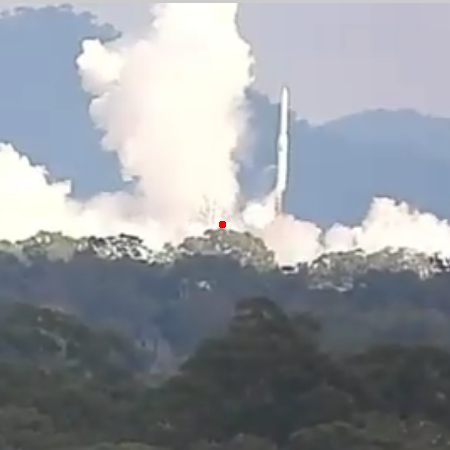
Eris rocket falling sideways from launchpad
(indicated by red dot). Click for video, cued
to just before launch.
According to a presentation by the CEO and founder of Australian rocket startup Gilmour Space, the company now sufficiently understands what caused the failure on its first launch attempt on July 30 to plan a second attempt in 2026.
The company is still investigating the root cause of the failure. “It looks like what went wrong on the launch is something we’ve never tested close enough to the launch conditions before,” he said, but didn’t elaborate.
One factor in the launch was the long delay between shipping the rocket to the launch site, known as the Bowen Orbital Spaceport, and the launch itself. “Rockets aren’t designed to be at the launch site for 18 months,” he said. The launch site, he noted, is just a kilometer from the ocean, creating salty conditions that can be corrosive.
That extended time at the launch site stemmed from delays securing regulatory approvals for the launch. That included not just a launch license from the Australian Space Agency but also airspace, maritime and environmental permits. “We had to get 24 different permits from the Queensland government,” Gilmour said. “All of these things take a long time to do.” He acknowledged that the company had not put enough resources into those regulatory processes. “The approval processes just took way too long.”
What is ironic is that as bad as Australia appears to be in terms of red tape, it is far better that it mother country, Great Britain. At least in Australia spaceports have been approved and at least one launch has taken place. And it only took eighteen months! In Great Britain the permitting process for its two proposed rocket spaceports has taken almost a decade, and still no vertical launches have occurred at either.

Eris rocket falling sideways from launchpad
(indicated by red dot). Click for video, cued
to just before launch.
According to a presentation by the CEO and founder of Australian rocket startup Gilmour Space, the company now sufficiently understands what caused the failure on its first launch attempt on July 30 to plan a second attempt in 2026.
The company is still investigating the root cause of the failure. “It looks like what went wrong on the launch is something we’ve never tested close enough to the launch conditions before,” he said, but didn’t elaborate.
One factor in the launch was the long delay between shipping the rocket to the launch site, known as the Bowen Orbital Spaceport, and the launch itself. “Rockets aren’t designed to be at the launch site for 18 months,” he said. The launch site, he noted, is just a kilometer from the ocean, creating salty conditions that can be corrosive.
That extended time at the launch site stemmed from delays securing regulatory approvals for the launch. That included not just a launch license from the Australian Space Agency but also airspace, maritime and environmental permits. “We had to get 24 different permits from the Queensland government,” Gilmour said. “All of these things take a long time to do.” He acknowledged that the company had not put enough resources into those regulatory processes. “The approval processes just took way too long.”
What is ironic is that as bad as Australia appears to be in terms of red tape, it is far better that it mother country, Great Britain. At least in Australia spaceports have been approved and at least one launch has taken place. And it only took eighteen months! In Great Britain the permitting process for its two proposed rocket spaceports has taken almost a decade, and still no vertical launches have occurred at either.



